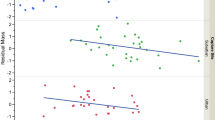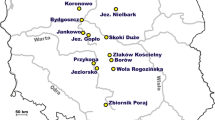Abstract
Melanin-based colouration of tegument structures may be related to variability in the expression of certain strategies or behaviours within a species, including the propensity to disperse. This is because melanin synthesis may be physiologically linked to certain behaviours and personality traits, as proposed by the hypothesis of the pleiotropy in the melanocortin system (HPMS). During a 28-year period (1988–2015), we studied the melanin-based dorsal colouration of male pied flycatchers (Ficedula hypoleuca) in relation to natal dispersal movements between contrasting (pine and oak) habitats. In addition, the relationship between tonic immobility (TI), a measure of individual fearfulness towards predators, and plumage colour was examined using a shorter time series. Consistent with HPMS, males’ dispersal propensity was related to their plumage colour, with the blackest individuals being more likely to disperse into a new habitat to breed. Blacker males remained for longer in TI than lighter ones. The positive relationship between plumage melanisation and TI might result from the pleiotropic effect of the melanocortin system on glucocorticoid-mediated stress and fearfulness responses as well as on eumelanin synthesis. This study provides solid empirical support for the HPMS in relation to natal dispersal behaviour.
Significance statement
Individual behaviour can be integrated with other phenotypic traits via the pleiotropic effects of some biochemical pathways. Recent research has shown connections between melanin-based colouration, personality and certain life history traits. However, the relationship between colouration and natal dispersal—a critical phase of life—has received comparatively little attention. We studied this link in the pied flycatcher, a small bird in which males exhibit considerable variation in dorsal plumage colour, ranging from brown to black. By following individuals from fledging to settlement, we show that males with a higher percentage of black feathers are more likely to disperse into novel environments than lighter males. Furthermore, we found an association between plumage melanisation and individual fearfulness to predators, possibly due to the shared pathways of melanin synthesis and stress responses. Our results highlight the potential of the interplay between melanin production and individual behaviour to explain the maintenance of colour variability in natural populations.


Similar content being viewed by others
References
Almasi B, Jenni L, Jenni-Eiermann S, Roulin A (2010) Regulation of stress response is heritable and functionally linked to melanin-based coloration. J Evol Biol 23(5):987–996. https://doi.org/10.1111/j.1420-9101.2010.01969.x
Bates D, Maechler M, Bolker B (2011) lme4: linear mixed-effects models using S4 classes. R Package Version 0999375–42. http://CRAN.R-project.org/package=lme4
Bélichon S, Clobert J, Massot M (1996) Are there differences in fitness components between philopatric and dispersing individuals? Acta Oecol 17:503–517
Bize P, Daniel G, Viblanc VA, Martin JG, Doligez B (2017) Negative phenotypic and genetic correlation between natal dispersal propensity and nest-defence behaviour in a wild bird. Biol Lett 13(7):20170236. https://doi.org/10.1098/rsbl.2017.0236
van den Brink V, Dreiss AN, Roulin A (2012a) Melanin-based coloration predicts natal dispersal in the barn owl, Tyto alba. Anim Behav 84(4):805–812. https://doi.org/10.1016/j.anbehav.2012.07.001
van den Brink V, Henry I, Wakamatsu K, Roulin A (2012b) Melanin-based coloration in juvenile Kestrels (Falco tinnunculus) covaries with anti-predatory personality traits. Ethology 118(7):673–682. https://doi.org/10.1111/j.1439-0310.2012.02057.x
van den Brink V, Dolivo V, Falourd X, Dreiss AN, Roulin A (2012c) Melanic color-dependent antipredator behavior strategies in barn owl nestlings. Behav Ecol 23(3):473–480. https://doi.org/10.1093/beheco/arr213
Camacho C, Canal D, Potti J (2013) Nonrandom dispersal drives phenotypic divergence within a bird population. Ecol Evol 3(14):4841–4848. https://doi.org/10.1002/ece3.563
Camacho C, Canal D, Potti J (2015) Testing the matching habitat choice hypothesis in nature: phenotype-environment correlation and fitness in a songbird population. Evol Ecol 29(6):873–886. https://doi.org/10.1007/s10682-015-9793-4
Camacho C, Canal D, Potti J (2016) Natal habitat imprinting counteracts the diversifying effects of phenotype-dependent dispersal in a spatially structured population. BMC Evol Biol 16(1):158. https://doi.org/10.1186/s12862-016-0724-y
Camacho C, Canal D, Potti J (2017) Lifelong effects of trapping experience lead to age-biased sampling: lessons from a wild bird population. Anim Behav 128:133–139
Carere C, Caramaschi D, Fawcett TW (2010) Covariation between personalities and individual differences in coping with stress: converging evidence and hypotheses. Curr Zool 56:728–740
Clobert J, Le Galliard JF, Cote J, Meylan S, Massot M (2009) Informed dispersal, heterogeneity in animal dispersal syndromes and the dynamics of spatially structured populations. Ecol Lett 12(3):197–209. https://doi.org/10.1111/j.1461-0248.2008.01267.x
Cockrem JF (2005) Conservation and behavioural neuroendocrinology. Horm Behav 48(4):492–501. https://doi.org/10.1016/j.yhbeh.2005.03.008
Cockrem JF (2007) Stress, corticosterone responses and avian personalities. J Ornithol 148(S2):169–178. https://doi.org/10.1007/s10336-007-0175-8
Cote J, Clobert J, Brodin T, Fogarty S, Sih A (2010) Personality-dependent dispersal: characterization, ontogeny and consequences for spatially structured populations. Philos T Roy Soc B 365(1560):4065–4076. https://doi.org/10.1098/rstb.2010.0176
Davis JM, Stamps J (2004) The effect of natal experience on habitat preferences. Trends Ecol Evol 19(8):411–416. https://doi.org/10.1016/j.tree.2004.04.006
Dingemanse NJ, Both C, van Noordwijk AJ, Rutten AL, Drent PJ (2003) Natal dispersal and personalities in great tits (Parus major). Proc R Soc Lond B 270(1516):741–747. https://doi.org/10.1098/rspb.2002.2300
Doligez B, Pärt T, Danchin E, Clobert J, Gustafsson L (2004) Availability and use of public information and conspecific density for settlement decisions in the collared flycatcher. J Anim Ecol 73(1):75–87. https://doi.org/10.1111/j.1365-2656.2004.00782.x
Dreiss AN, Antoniazza S, Burri R, Fumagalli L, Sonnay C, Frey C, Goudet J, Roulin A (2012) Local adaptation and matching habitat choice in female barn owls with respect to melanic coloration. J Evol Biol 25(1):103–114. https://doi.org/10.1111/j.1420-9101.2011.02407.x
Drost R (1936) Über das Brutkleid männlicher Trauerfliegenfanger, Muscicapa hypoleuca. Vogelzug 6:179–186
Ducrest AL, Keller L, Roulin A (2008) Pleiotropy and the melanocortin system, coloration and behavioural syndromes. Trends Ecol Evol 23(9):502–510. https://doi.org/10.1016/j.tree.2008.06.001
Edelaar P, Serrano D, Carrete M, Blas J, Potti J, Tella JL (2012) Tonic immobility is a measure of boldness towards predators: an application of Bayesian structural equation modelling. Behav Ecol 23(3):619–626. https://doi.org/10.1093/beheco/ars006
Fraser DF, Gilliam JF, Daley MJ, Le AN, Skalski GT (2001) Explaining leptokurtic movement distributions: intrapopulation variation in boldness and exploration. Am Nat 158(2):124–135. https://doi.org/10.1086/321307
Galván I, Wakamatsu K (2016) Color measurement of the animal integument predicts the content of specific melanin forms. RSC Adv 6(82):79135–79142. https://doi.org/10.1039/C6RA17463A
Garant D, Kruuk LE, Wilkin TA, McCleery RH, Sheldon BC (2005) Evolution driven by differential dispersal within a wild bird population. Nature 433(7021):60–65. https://doi.org/10.1038/nature03051
Greenwood PJ, Harvey PH (1982) The natal and breeding dispersal of birds. Annu Rev Ecol Syst 13(1):1–21. https://doi.org/10.1146/annurev.es.13.110182.000245
Holt RD, McPeek MA (1996) Chaotic population dynamics favors the evolution of dispersal. Am Nat 148(4):709–719. https://doi.org/10.1086/285949
Johnson ML, Gaines MS (1990) Evolution of dispersal: theoretical models and empirical tests using birds and mammals. Annu Rev Ecol Syst 21(1):449–480. https://doi.org/10.1146/annurev.es.21.110190.002313
Jones RB, Faure JM (1981) Tonic immobility (“righting time”) in laying hens housed in cages and pens. Appl Anim Ethol 7(4):369–372. https://doi.org/10.1016/0304-3762(81)90063-8
Karlsson L, Persson K, Walinder G (1986) Ageing and sexing in pied flycatchers, Ficedula hypoleuca. Vår Fågelvärld 45:131–146
Laaksonen T, Sirkiä PM, Calhim S, Brommer JE, Leskinen PK, Primmer CR, Adamík P, Artemyev AV, Belskii E, Both C, Bureš S, Burgess MD, Doligez B, Forsman JT, Grinkov V, Hoffmann U, Ivankina E, Král M, Krams I, Lampe HM, Moreno J, Mägi M, Nord A, Potti J, Ravussin PA, Sokolov L (2015) Sympatric divergence and clinal variation in multiple coloration traits of Ficedula flycatchers. J Evol Biol 28(4):779–790. https://doi.org/10.1111/jeb.12604
Lehtonen PK, Laaksonen T, Artemyev AV et al (2009) Geographic patterns of genetic differentiation and plumage colour variation are different in the pied flycatcher (Ficedula hypoleuca). Mol Ecol 18(21):4463–4476. https://doi.org/10.1111/j.1365-294X.2009.04364.x
Lessells CM, Boag PT (1987) Unrepeatable repeatabilities: a common mistake. Auk 104(1):116–121. https://doi.org/10.2307/4087240
Liu SY, Shawkey MD, Parkinson D, Tyler P, Troy TP, Ahmed M (2014) Elucidation of the chemical composition of avian melanin. RSC Adv 4(76):40396–40399. https://doi.org/10.1039/C4RA06606E
Lundberg A, Alatalo RV (1992) The pied flycatcher. Poyser, London
McGraw KJ (2006) Mechanics of melanin-based coloration. In: Hill GE, McGraw KJ (eds) Bird Coloration, Mechanisms and Measurements, vol I. Harvard University Press, Harvard, pp 243–294
Mills AD, Faure JM (1991) Divergent selection for duration of tonic immobility and social reinstatement behavior in Japanese quail (Coturnix coturnix japonica) chicks. J Comp Psychol 105(1):25–38. https://doi.org/10.1037/0735-7036.105.1.25
Mills AD, Faure JM (2000) Ease of capture in lines of Japanese quail (Coturnix japonica) subjected to contrasting selection for fear or sociability. Appl Anim Behav Sci 69(2):125–134. https://doi.org/10.1016/S0168-1591(00)00126-X
Nicolaus M, Piault R, Ubels R, Tinbergen JM, Dingemanse NJ (2016) The correlation between colouration and exploration behaviour varies across hierarchical levels in a wild passerine bird. J Evol Biol 29(9):1780–1792. https://doi.org/10.1111/jeb.12907
Nunes S, Duniec TR, Schweppe SA, Holekamp KE (1999) Energetic and endocrine mediation of natal dispersal behavior in Belding’s ground squirrels. Horm Behav 35(2):113–124. https://doi.org/10.1006/hbeh.1998.1504
Potti J, Merino S (1994) Heritability estimates and maternal effects on tarsus length in pied flycatchers, Ficedula hypoleuca. Oecologia 100(3):331–338. https://doi.org/10.1007/BF00316962
Potti J, Montalvo S (1991a) Male arrival and female mate choice in pied flycatchers Ficedula hypoleuca in Central Spain. Ornis Scand 22(1):45–54. https://doi.org/10.2307/3676620
Potti J, Montalvo S (1991b) Return rate, age at first breeding and natal dispersal of pied flycatchers Ficedula hypoleuca in central Spain. Ardea 79:419–428
Réale D, Reader SM, Sol D, McDougall PT, Dingemanse NJ (2007) Integrating animal temperament within ecology and evolution. Biol Rev 82(2):291–318. https://doi.org/10.1111/j.1469-185X.2007.00010.x
Roulin A (2013) Ring recoveries of dead birds confirm that darker pheomelanic barn owls disperse longer distances. J Ornithol 154(3):871–874. https://doi.org/10.1007/s10336-013-0949-0
Roulin A, Ducrest AL (2011) Association between melanism, physiology and behaviour: a role for the melanocortin system. Eur J Pharmacol 660(1):226–233. https://doi.org/10.1016/j.ejphar.2011.01.036
Saino N, Romano M, Scandolara C, Rubolini D, Ambrosini R, Caprioli M, Costanzo A, Romano A (2014) Brownish, small and lousy barn swallows have greater natal dispersal propensity. Anim Behav 87:137–146. https://doi.org/10.1016/j.anbehav.2013.10.022
Senar JC, Conroy MJ, Borras A (2002) Asymmetric exchange between populations differing in habitat quality: a metapopulation study on the citril finch. J Appl Stat 29(1-4):425–441. https://doi.org/10.1080/02664760120108791
Trochet A, Courtois EA, Stevens VM, Baguette M, Chaine A, Schmeller DS, Clobert J (2016) Evolution of sex-biased dispersal. Q Rev Biol 91(3):297–320. https://doi.org/10.1086/688097
Tschirren B, Fitze PS, Richner H (2007) Maternal modulation of natal dispersal in a passerine bird: an adaptive strategy to cope with parasitism? Am Nat 169(1):87–93. https://doi.org/10.1086/509945
Wuerz Y, Krüger O (2015) Personality over ontogeny in zebra finches: long-term repeatable traits but unstable behavioural syndromes. Front Zool 12(Suppl 1):S9. https://doi.org/10.1186/1742-9994-12-S1-S9
Acknowledgements
We thank María Cuenca-Cambronero, Alba Ruiz-Ramos, Marta Guntiñas, Javier Manzano-Baraza, Gerardo Jiménez-Navarro, David Ochoa, Tomás Redondo, Fran Romero, Gregorio Moreno-Rueda, Inés Valencia and Óscar Frías for help with fieldwork. We are grateful to Alexandre Roulin and three anonymous reviewers for their constructive comments on a previous draft.
Funding
Long-term monitoring of the study population has been mainly funded by the Spanish CCYT, most recently by projects CGL2014-55969-P (to F. Valera) and CGL201570639-P (to L.Z. Garamszegi) of the Spanish Ministry of Economy and Competitiveness. CC received financial support from the Spanish Ministry of Economy and Competitiveness (SVP-2013-067686). LP-R was supported by a postdoctoral contract from MINECO through the Severo Ochoa Programme for Centres of Excellence in RandDandI (SEV-2012-0262). DC was supported by projects CGL2009-10652 and CGL2015-70639-P.
Author information
Authors and Affiliations
Corresponding author
Ethics declarations
Ethical approval
Birds were caught and ringed under licences from the Ringing Office of the Spanish Ministry of Agriculture, Food, Fisheries and Environment. All work was subject to review by the ethical committees at the Doñana Biological Station and the CSIC headquarters (Spain) and adhered to Spain standard requirements.
Conflict of interest
The authors declare that they have no conflict of interest.
Additional information
Communicated by K. McGraw
Rights and permissions
About this article
Cite this article
Camacho, C., Pérez-Rodríguez, L., Abril-Colón, I. et al. Plumage colour predicts dispersal propensity in male pied flycatchers. Behav Ecol Sociobiol 72, 2 (2018). https://doi.org/10.1007/s00265-017-2417-y
Received:
Revised:
Accepted:
Published:
DOI: https://doi.org/10.1007/s00265-017-2417-y




